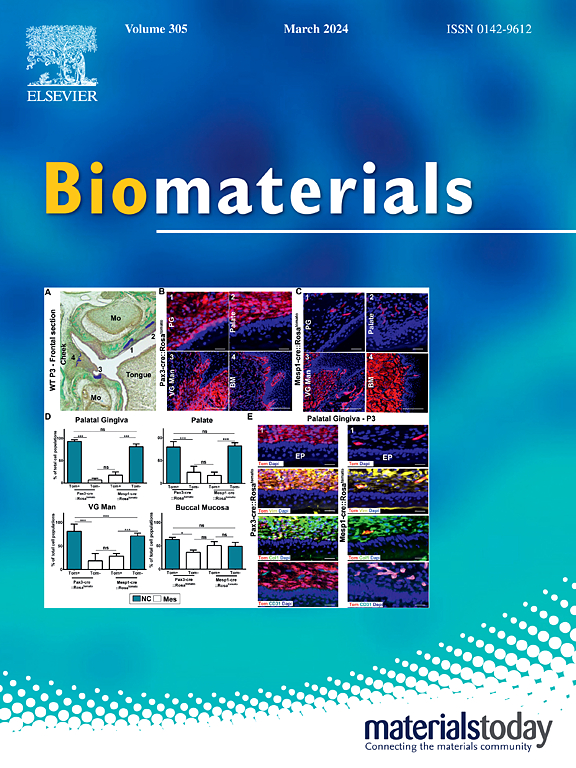Mechanistic insights and therapeutic applications of metal-based nanomaterials in oral infectious diseases: Current advances and future perspectives
IF 12.9
1区 医学
Q1 ENGINEERING, BIOMEDICAL
引用次数: 0
Abstract
Oral infectious diseases, including dental caries, pulpitis, periodontitis, peri-implantitis, and osteomyelitis of the jaws, are among the most prevalent conditions in dentistry, primarily caused by bacterial infections. Traditional treatment approaches, such as mechanical debridement and antibiotic therapy, face limitations due to bacterial resistance, inadequate infection control, and the inability to promote tissue regeneration effectively. Metal-based nanomaterials have emerged as promising candidates for addressing these challenges, offering broad-spectrum antibacterial activity, immunomodulation, and regenerative properties. This review provides an in-depth analysis of the therapeutic potential of metal-containing nanomaterials in managing oral infectious diseases. It explores their antibacterial mechanisms, including membrane disruption, oxidative stress induction, and metabolic interference. Additionally, we discuss their role in modulating inflammation and promoting tissue regeneration through stem cell differentiation and extracellular matrix remodeling. The application of these nanomaterials in caries prevention, endodontic therapy, periodontal treatment, and implantology is critically examined. Finally, we highlight key challenges, including biosafety concerns, clinical translation hurdles, and material optimization strategies. By summarizing recent advances and emerging trends, this review aims to provide insights into the development of innovative nanotherapeutics for enhanced oral healthcare.
金属基纳米材料在口腔感染性疾病中的机制见解和治疗应用:当前进展和未来展望
口腔传染病,包括龋齿、牙髓炎、牙周炎、种植体周围炎和颌骨骨髓炎,是牙科中最常见的疾病,主要由细菌感染引起。传统的治疗方法,如机械清创和抗生素治疗,由于细菌耐药性,感染控制不足,无法有效促进组织再生,面临局限性。金属基纳米材料已经成为解决这些挑战的有希望的候选者,具有广谱抗菌活性,免疫调节和再生特性。本文综述了含金属纳米材料在口腔感染性疾病治疗中的潜力。它探讨了它们的抗菌机制,包括膜破坏,氧化应激诱导和代谢干扰。此外,我们还讨论了它们在调节炎症和通过干细胞分化和细胞外基质重塑促进组织再生中的作用。这些纳米材料在龋齿预防、牙髓治疗、牙周治疗和种植方面的应用被严格审查。最后,我们强调了主要挑战,包括生物安全问题、临床翻译障碍和材料优化策略。通过总结最近的进展和新兴趋势,本综述旨在为创新纳米疗法的发展提供见解,以增强口腔保健。
本文章由计算机程序翻译,如有差异,请以英文原文为准。
求助全文
约1分钟内获得全文
求助全文
来源期刊

Biomaterials
工程技术-材料科学:生物材料
CiteScore
26.00
自引率
2.90%
发文量
565
审稿时长
46 days
期刊介绍:
Biomaterials is an international journal covering the science and clinical application of biomaterials. A biomaterial is now defined as a substance that has been engineered to take a form which, alone or as part of a complex system, is used to direct, by control of interactions with components of living systems, the course of any therapeutic or diagnostic procedure. It is the aim of the journal to provide a peer-reviewed forum for the publication of original papers and authoritative review and opinion papers dealing with the most important issues facing the use of biomaterials in clinical practice. The scope of the journal covers the wide range of physical, biological and chemical sciences that underpin the design of biomaterials and the clinical disciplines in which they are used. These sciences include polymer synthesis and characterization, drug and gene vector design, the biology of the host response, immunology and toxicology and self assembly at the nanoscale. Clinical applications include the therapies of medical technology and regenerative medicine in all clinical disciplines, and diagnostic systems that reply on innovative contrast and sensing agents. The journal is relevant to areas such as cancer diagnosis and therapy, implantable devices, drug delivery systems, gene vectors, bionanotechnology and tissue engineering.
 求助内容:
求助内容: 应助结果提醒方式:
应助结果提醒方式:


